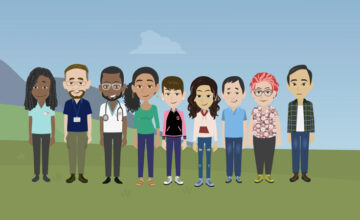
Curriculum Summary
From the food we eat, to the water we drink, to the places where we live and play, soil erosion and sedimentation profoundly affects our everyday lives. The loss of soil from our landscapes and its deposition into our waterways, reduce the ability of the land to be productive in supporting plant growth and the capacity of the water to nurture aquatic habitats, host recreation, and have municipal usefulness. Erosion is a natural occurrence, shaping sand dunes, creating river deltas, or carving out enormous rock features like the Grand Canyon. This curriculum focuses on the accelerated processes of erosion and sedimentation that transpire as a direct result of agricultural and construction development activities. It is through abuse that our waters and soils are becoming increasingly compromised. With careful management of the soil, however, we can preserve water quality and keep our soil in place for future generations.
Soil to Seed is designed to cultivate high school aged-youth in understanding the principles of erosion and sediment control. Using the 4-H Experiential Learning Model, youth delve into hands-on lessons, working together to solve problems and share reflections on what they learned. The curriculum begins with the fundamental mechanics behind erosion and sedimentation, then teaches students how to assess physical spaces for evidence of these processes, and eventually builds their knowledge base of how to manage and control soil loss and deposition. Students strengthen their connections to these concepts through the process of doing, reflecting, and then applying what they know to other situations in their life. Each lesson is crafted to build life skills that can be used in any context, fostering critical thinking, teamwork, record keeping, collaboration, and communication.
Age range: 14-18
Grade level: High School
Introduction to Soil Erosion
Next Generation Science Standards
Earth and Human Activity (HS-ESS3-1.)
Construct an explanation based on evidence for how the availability of natural resources, the occurrence of natural hazards, and changes in climate have influenced human activities.
Learner Outcomes
Students will broadly explore soil erosion to understand the physical mechanisms behind the process of erosion and the impacts that sediment has on water quality. Students will form a scientific learning community and share their ideas and findings through a blog.
Site Assessment
Next Generation Science Standards
Earth and Human Activity (HS-ESS3-1.)
Construct an explanation based on evidence for how the availability of natural resources, the occurrence of natural hazards, and changes in climate have influenced human activity.
Engineering Design (HS-ETS1-2.)
Design a solution to a complex real-world problem by breaking it down into smaller, more manageable problems that can be solved through engineering.
Learner Outcomes
Students will determine how to identify existing and potential areas of erosion and sedimentation on their school campuses. They will collectively work to create an experiment to test erosion and sediment control.
Soil Properties
Next Generation Science Standards
Earth and Human Activity (HS-ESS3-1.)
Construct an explanation based on evidence for how the availability of natural resources, the occurrence of natural hazards, and changes in climate have influenced human activity.
Learner Outcome
Students will understand how soil properties influence the rate and control of erosion. They will grow their knowledge of how soil properties relate to the management of soil erosion and sedimentation.
Rainbox Throwdown Experiment
Next Generation Science Standards
Earth and Human Activity (HS-ESS3-2.)
Evaluate competing design solutions for developing, managing, and utilizing energy and mineral resources based on cost-benefit ratios.
Engineering Design
(HS-ETS1-2.) Design a solution to a complex real-world problem by breaking it down into smaller, more manageable problems that can be solved through engineering.
(HS-ETS1-3.) Evaluate a solution to a complex real-world problem based on prioritized criteria and trade-offs that account for a range of constraints, including cost, safety, reliability, and aesthetics, as well as possible social, cultural, and environmental impacts.
Learner Outcomes
Students will engage in hands-on experiments that will serve as a basis for understanding the mechanics behind erosion and sediment control. They will develop ideas on ways to manage these processes.
Measuring Soil Erosion and Sediment Control: Best Management Practices
Next Generation Science Standards
Earth and Human Activity (HS-ESS3-4.)
Evaluate or refine a technological solution that reduces the impacts of human activities on natural systems.
Learner Outcomes
Students will investigate and analyze the best management practices commonly used to control soil erosion, sedimentation, and turbidity and their effectiveness to reduce pollution and improve water quality.
Soil Erosion and Sediment Control Policy and BMP Mapping
Next Generation Science Standards
Engineering Design
(HS-ETS1-1.) Analyze a major global challenge to specify qualitative and quantitative criteria and constraints for solutions that account for societal needs and wants.
(HS-ETS1-2.) Design a solution to a complex real-world problem by breaking it down into smaller, more manageable problems that can be solved through engineering.
(HS-ETS1-3.) Evaluate a solution to a complex real-world problem based on prioritized criteria and trade-offs that account for a range of constraints, including cost, safety, reliability, and aesthetics, as well as possible social, cultural, and environmental impacts.
Learner Outcomes
Students will work as a team to decide which best management practices are suitable for different construction or agricultural sites depending on a given scenario. Students will explore the different state and national regulations that guide their decisions.




